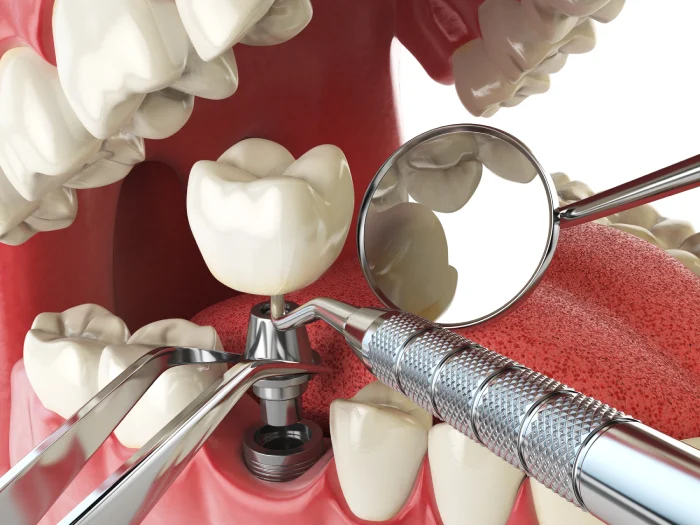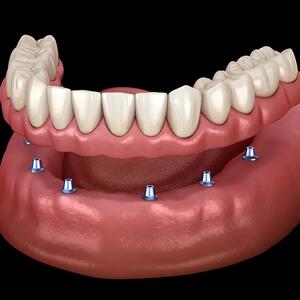Molar Tooth Implantation
Lost a molar tooth and feeling discomfort? Our article on Dental Portal will tell you about implantation methods that help restore teeth with maximum functionality and aesthetics. Discover how the right choice of implant can change your life.
Features of Molar Tooth Implantation
The side teeth (molars and premolars) are essential for grinding food. Their loss affects the ability to chew and the bite. After the loss of these teeth, the temporomandibular joint wears out more quickly, and the facial shape changes.
The average chewing pressure on the side teeth is 40–60 kg for women and 50–80 kg for men, which is 2–3 times higher than on the front teeth. When choosing an implant for molar teeth, the primary focus is on functionality.
- Due to the high load on the molar teeth, the volume of bone tissue is very important. If necessary, osteoplasty is performed, including bone grafting in the lower jaw or sinus lifting in the upper jaw.
- The choice of implants for molar teeth and the need for bone grafting are determined during the planning stage. A computer tomography is carried out, and a 3D model is created. This model shows the structure of the jaws, the location of vessels, nerves, and sinus cavities. A virtual operation is also conducted on the model to preview the future appearance of the molar implants in photos.
- When placing crowns on implants for molar teeth, the emphasis is on durability. Prostheses made of zirconium dioxide or metal-ceramic are used, and for the side teeth, E-max ceramic.
Implantation of Lower Molar Teeth

Dense bone. The lower jaw has dense bone with a thick cortical layer. When a tooth is lost, the bone hardly atrophies, allowing the use of larger titanium posts without additional bone grafting.
Short period of osseointegration. Implants in the lower jaw integrate more quickly – within up to 3 months. Due to the better quality of the bone, the stability of the implants is higher than in the upper jaw.
Mandibular nerve. During operations in the lower jaw, it's important to consider the position of the mandibular nerve to avoid its damage during implant placement.
Implantation of Upper Molar Teeth
Rough bone. The upper jaw is less dense as it receives less chewing forces. It mainly consists of spongy bones.
Prolonged engraftment period. The osseointegration of implants in the upper jaw can take up to 6 months, twice as long as in the lower jaw. To accelerate the process, implants with enhanced coatings, such as Astra Tech, are used.
Maxillary sinuses. When implanting in the upper jaw, the proximity of the sinus cavities must be considered. After tooth loss, the upper jaw quickly atrophies. A sinus lift may be necessary to prevent damage to the nasal cavity.
Indications
Implants for molar teeth are placed in the following cases:
- absence of one or several teeth;
- severely damaged crowns that cannot be restored;
- broken or atrophied roots;
- inflammatory processes at the root tips.
Why are implants the best option for restoring molar teeth?
To create bridges, at least two teeth need to be devitalized and prepared for crowns. Removable and partial removable dentures are often insecurely fixed and irritate the gums. Implants maintain the natural load on the alveolar ridge, preventing bone resorption.
Which Implants Are Suitable for Molar Teeth?
- Increased diameter. Implants with an increased diameter ensure reliable stabilization and prevent mobility.
- Thread design. A thread design with wide turns strengthens the implant in the bone tissue, which is important for bearing increased chewing loads.
- Hydrophilic surface. A hydrophilic surface facilitates the implant's faster integration into the bone.
Methods of Implantation for Molar Teeth
The method of implantation depends on the number of missing teeth, the condition of the bone tissue, and the patient's physiological characteristics.
Missing a Side Tooth
If a tooth has been missing for a long time, classical two-stage implantation with delayed loading is the best option. If the damaged tooth is still in the socket, removal followed by immediate implant placement can be performed.
Missing Several Molars and Premolars in a Row
When a patient is missing several molars or premolars, the doctor determines their number. For the loss of 2–3 teeth, a two-stage implantation method is usually used. If more than three teeth are missing, a one-stage implantation with immediate loading is performed.
Absence of Crowns on Both Sides
First, the condition of the front teeth is assessed. If they are intact, only the side teeth are replaced with implants. If the front teeth are significantly damaged, they are removed and full prosthesis methods like All-on-6 or All-on-4 are applied.
Unstable or Damaged Rear Molars
The best solution in terms of cost and speed is immediate implantation. The damaged tooth is removed, bone grafting is performed, and an artificial root is implanted.
Stages of Implantation
The restoration of the dental arch occurs in several stages:
carrying out analyses and examinations, taking x-rays, CT scans of the jaws, and creating a 3D model.
oral hygiene, removal of damaged teeth, treatment of diseases.
performed when the height of the alveolar ridge is insufficient.
implant placement, closure placement, and suturing. After 3–6 months, the closure is replaced with an abutment.
after complete osseointegration, bridges or individual crowns are fixed on the implants.
Contraindications
| Relative | Absolute |
|---|---|
| Type 2 diabetes | Type 1 diabetes |
| Osteoporosis | Cancer or recovery period after oncological diseases |
| Smoking | Autoimmune diseases |
| Occlusal defects | Central nervous system disorders |
| Untreated dental and oral mucosal diseases. | Tuberculosis |
| Bruxism (intense teeth grinding or clenching) | |
| Poor oral hygiene |
When Is Bone Grafting Needed in the Lateral Section?
Bone grafting is a procedure to increase the volume of the jawbone. It is necessary when the height of the alveolar ridge is insufficient for implantation: at least 10-12 mm for upper molars and 8-10 mm for lower molars. It increases the cost of implant placement, but is necessary when the alveolar ridge height is low due to:
- age-related changes;
- jaw trauma;
- natural atrophy after tooth extraction;
- congenital features.
Care and Rehabilitation Post-Implantation
Following these guidelines will help speed up recovery and prevent complications:
- Refrain from smoking for at least 2 weeks post-operation.
- Take medications prescribed by your doctor, including antibiotics.
- Perform oral rinses for the first 4 days, then clean teeth with a soft brush from day 5.
- Use an irrigator from day 14 to 21 after surgery.
- Do not use an electric toothbrush until the implant has fully integrated.
- Eat soft food for the first month, avoiding spicy, acidic, and peppery foods.
- Do not touch the implant site with your tongue.
- After a sinus lift, be careful when sneezing, coughing, and blowing your nose.
- Avoid physical activity, sauna, and steam room for the first 7-14 days.
Questions and Answers on Molar Implantation
What is molar implantation?
It is the replacement of lost or severely damaged molars and premolars with titanium implants, which then support crowns that mimic natural teeth.
What factors are important when choosing an implant for molars?
The volume and density of the bone, the design of the implant, its hydrophilicity, and the individual characteristics of the patient should be considered.
What are the methods of molar implantation?
Methods range from classic two-stage implantation to one-stage with immediate loading, as well as special protocols like All-on-4 or All-on-6 for extensive tooth loss.
What are the contraindications for molar implantation?
Systemic diseases, poor oral hygiene, untreated oral diseases, bruxism, and smoking.
What are the stages of implantation?
They include diagnostics, preparation, bone grafting if necessary, implantation, and prosthetics.
How should one care and rehabilitate after implantation?
Maintain oral hygiene, avoid heavy loads and tobacco, and follow all doctor's recommendations.
When is bone grafting needed in implantation?
If the alveolar ridge is too low, which can be caused by atrophy, injury, or congenital features. Bone grafting increases the volume of the bone.


